- Getting around Lijiang. Dont stay in the Old Towns more than 2 days, there is nothing to do. KRISS Oct 9, 2013 05:46
- 2013 Beijing Temple Fair BENNYLAU Feb 26, 2013 03:29
- Malaysian traveling from KUL - LAX vis Shanghai PVG ZATI_DY Jan 3, 2013 20:15
Xijiang's Miao Majority
- Views: 5157
- |Vote: 1 0
- |Add to Favorites
- |Recommend to Friends
The water was off in our hotel by 7.30 before we made our way over to the station to catch the 9.00am bus to Xijiang. It was pulling out as we arrived but we soon discovered the driver was in no hurry to leave until he could find more passengers. He crawled along with the conductor hustling anyone who looked our way. We crossed the river and continued crawling right by our hotel – we could have picked it up at the door – and slowly followed the road upstream beside the river. Recent heavy rains had caused landslides and washouts making travel slow and torturous in places where the road had slipped down the mountain side or into the creek. Of course this slower pace has the advantage of allowing more time to enjoy the scenery and the other passengers who included children with schoolbags and books and a menagerie of chickens and pigs.
Despite being an unsealed road with many obstacles it was one of the best gravel roads we had encountered thus far. Xijiang, deep in the Leigong hills is supposedly the largest Miao village in the country and as such does see a significant number of visitors but you would never know it. We arrived late in the morning on a beautiful hot summer’s day. Late in the rice growing season of lime green terraces like stretch lacework from the valley floor to the tree line on the upper slopes of the forested hills.
Xijiang has only one main street and the bus announces its departure and arrival with short blasts on the horn as it cruises slowly in and out of town. At one end of the main street is a busy market, a modest hotel with a courtyard for folk dance displays for the busloads of tourist who visit or stay overnight and one or two more modern buildings.
There are no fancy restaurants or bars but you will find a couple of small diners on the street to buy baozi, noodles and something for breakfast. By the time we had finished eating, school was out and the local children were making their way home for lunch. We followed a couple of youngster, chatting as we made our way back up the street towards the edge of the village. They pointed up the hill towards their homes. We had come for a closer look at the lives of the Miao and so we followed them up the hill with the expectation of meeting more villagers and stopping for a chat.
Most villages are built on slopes and Xijiang being no exception spreads out over three spurs and the intervening valleys along the range on the northern bank of the river. In the winter months these mountain villages are often buried in snow and heavy summer rains can turn the paths into rivers of mud. In 2002 a group of Australian volunteer’s with Aus Aid spent several weeks in the village concreting paths, stairways, threshing floors and a public square, all of which the residents are very proud of. It was up one of these paved paths that we ascended near the edge of the village as we followed the young students on their way home.
The view out over the lime green terraces in just magnificent and as we stood soaking in the view and contemplating which path we should take a woman emerged from the kitchen at the back of her home and without hesitation invited us inside. Although our expectation was to meet some villagers, to be invited inside so readily was indeed a serendipitous surprise. We were curious, she was insistent, so in we went. She asked if we had eaten yet – a common form of greeting – as she led us through the dark kitchen, via another small dingy room with stairs leading to the upper floor in to the living room in the front of the house. The natural light for this room came from the open doorway onto the narrow balcony with a seat running the full length below the railing.
This spacious and comfortable living room was simply furnished with an ancient three seater settee that had seen better days, a television and a rice cooker on an old sideboard, the small low table and stools where meals were eaten and a cane basket of sewing sat beside a treadle sewing machine. The dark, aged timber walls displayed some family photos and posters. Miao houses are generally well crafted, sturdy, spacious and clean and this was no exception with the added bonus of one of the best views in the village overlooking the rice terraces with a view of the valley as far as the eye could see.
Po po gestured for us to be seated while she sent her niece out to bring in some food for us. Athough we explained that we had just eaten she insisted that we share her simple meal of chilli potato with a bowl of rice. Noticing her basket of sewing we asked to see what kind of work she did. She took out her embroidered shoe soles and a pair of thick, chunky old glasses – I also took mine out to have a closer look. I’d lost a pair of glasses just days into this trip and had picked up another nice but cheap fold-up pair in a small compact case. We compared glasses and discovered that hers did not really aid her vision. However mine seemed to be a vast improvement – she got quite excited at how well she could see through them – so I gave them to her. Her niece then wrote a note in neat characters which my mother could easily read explaining that the family was not well off, farmed only a small area of land, still had three children in school and both parents were away working outside the village.
After our bite to eat Po po offered to show us around the village and at 65 year olds, despite having some problems with her legs she was rather hard to keep up with. Outside almost every home shucked corn lay drying on large woven bamboo mats that are rolled each evening and taken indoors. We took the path to the water tanks at the top of the village passing a merchant selling hand made straw brooms and farmers returning with baskets of green feed on shoulder poles for their animals. The village was quiet at this time of the day with just a few young children and dogs curious about the three strange visitors.
The Miao women of Xijiang wear their long dark hair coiled up in neat buns on the top of their heads, the younger women preferring to adorn them with large colourful plastic or bone combs and pretty flowers. The older women like Popo are a little more conservative, covering their hair with small usually pastel coloured ‘terry cloth’ hand towels before leaving the house. Few of them appear to wear their traditional clothing here but it can be purchased in a couple of shops selling local handcrafts of batik and recycled clothing and new creations from the least worn pieces of beautifully embroidered cast-off cloths.
My sister stood still too long and quickly found herself draped in several pieces of traditional clothing and an awesome 7 kilograms of silver jewellery. Each woman has her traditional clothing and head dress and other jewellery which is worn at special festivals throughout the year. This jewellery is a bit of a status symbol. The wealthier the family the more they invest in the daughters jewellery. We purchased a couple of light weight jackets using recycled but exquisite embroidery and I just love wearing mine on slightly cooler days.
In every village no matter its size there is always a flat open area used for dancing. We came across Xijiang’s open air dance floor as we descended the steep slope back to the main street. The area is laid with river stones in a pattern which radiates from the centre with a large shade tree at one end a basket ball hoop at the other. As we wandered back down to the main street we came across two men who had just slaughtered a pig, shaved its hair and were preparing to cut the carcass for sale. In the alley next to them were two butchers stalls – one lay napping beside the meat on his table in the shade of the umbrella while the other sat waiting ready for customers, with knife, scales and meat neatly displayed on the table.
Stone retaining walls along the riverbanks throughout the village were under construction to control the river’s flow and minimize flood damage. Overnight rain had turned the area into a bit of a quagmire while these major earthworks were still underway. The village school, a three story building in traditional style stood across the river on the opposite bank and as we approached the school bell rang for the resumption of afternoon classes and children playing in the shallow river dashed across the yard to their classrooms.
Po po took us into the only hotel to watch the traditional dance show being performed in the courtyard for a group of Chinese tourist who on seeing us quickly embraced us a part of their group and offered us the best seats and even took some photos with us – something we have had to get used to. However there was fee for the show and as we had not paid we were asked to buy a ticket or leave. Popo then took us down to meet another of her family members who as setting up a clothes stall in the square for the night markets.
The bus was waiting and soon began honking the horn to announce its departure. It was time for us to leave. While staying the night would have been preferable we had to get back to the hotel in Leishan. That evening over dinner in the ‘best restaurant in town’ we met three more French travellers – and we would later meet them again – one of whom was ethnic Chinese and spoke excellent Mandarin. We enjoyed a drink together and were able to communicate well with the family who ran our favourite and perhaps the only good restaurant in Leishan.



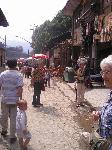
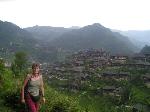
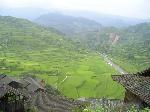
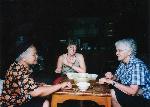

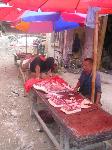

 Copyright © 1998-2025 All rights reserved.
Copyright © 1998-2025 All rights reserved.